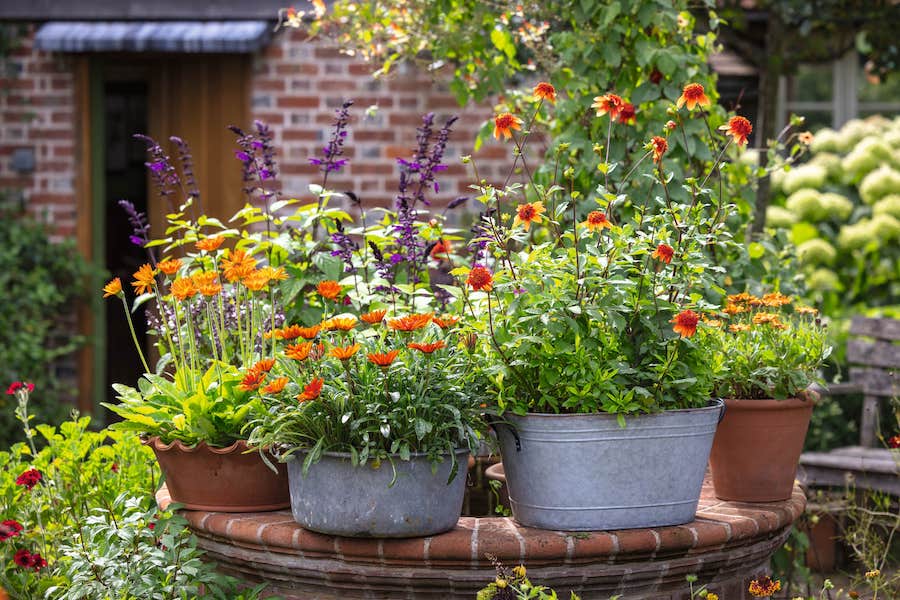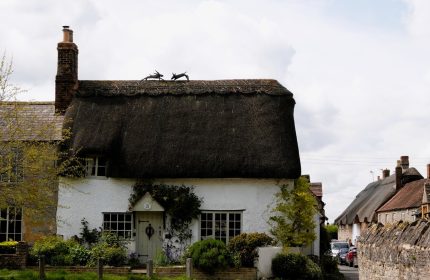How to choose and style your garden pots like a pro
Expert Sarah Raven offers tips on how to colour-match for the best effect in your outdoor space
It’s safe to say that gardener, teacher, nurserywoman and broadcaster Sarah Raven loves pots.
She says they’re essential to the character of the one-and-a-half acre garden at her home, Perch Hill in East Sussex, which is also the base of her garden school – and over the years, she and her team have trialled thousands of container plants, working out design rules for planting combinations in the process.
Now, she’d shared her knowledge in a beautiful new book, A Year Full Of Pots, which covers pots for every season and palette, from bulb lasagnes to jungle joy, climbers and insect-friendly combinations.
View this post on Instagram
The most common mistake gardeners make is picking up random plants in garden centres which they think look pretty, but they don’t have a design in mind, she observes.
”I’m very strict. I just give you the recipes and I say, ignore them at your peril. It’s like if you know what you are cooking for supper, you buy the right amount of food and don’t forget anything. It’s the same with creating a pot garden when you are doing the changeover from spring to summer.”
Here are some of Raven’s top tips for perfecting your pot game…
Colour palettes
Raven uses four colour palettes for her pots.
1. Dark and rich
View this post on Instagram
“I use crimsons and mahogany, deep purple and bronzes.” They suck up the light and she thinks of them as the velvet colours you envelop yourself in. They might include deep red dahlias, or tulips in shades of burnt orange and almost black.
“The dark and rich have to be in quite a well-lit place because otherwise they can form a bit of a black hole and be a bit on the sombre side,” she adds. “They need to be front of border or front of yard space, and be quite well lit, or backlit or planted with something sharp in colour behind them, like a euphorbia, so they are highlighted.”
2. Boiled-sweet brilliant
View this post on Instagram
“This includes really radiant, stained glass colours,” she explains, incorporating blackcurrant, strawberry, raspberry, orange, lemon, lime and cobalt blue. It might feature everything from zingy orange gerberas to raspberry red tulips and acid green euphorbias.
“I use this in one particular part of the garden that I walk through a lot and I want it to be stimulating and cheerful. Again, it needs good sunlight.”
3. Soft and warm

Coral Sand Tulip collection
“I call these the cashmere jersey colours, so it’s pastel but in the warm palette.” Think peach, milky coffee, ivory, faded coral and apricot.
“I love this palette in spring, particularly in my rose garden because the rose foliage when it first emerges in spring is copper and bronze and it really is beautiful with either the dark and rich or the soft and warm (colours) growing through it with pots of tulips.”
4. Soft and cool
View this post on Instagram
“These include mauves and pale blues.” Blue-pinks, primrose yellows and off-whites which get paler until you reach the pure white flower, could also feature.
“I tend to stick with one palette. I tend to grow three ingredients in a bigger size pot together, or if they’re smaller pots, I’d have them in three neighbouring pots,” she says. “These are fantastic for shining a torch into dark areas, so we have those all the way along the north face of our barn. We use this palette out into the view, so where we have a garden that tumbles off into the distance, I would always use the soft and cool. It’s very calm.”
Choosing plants
View this post on Instagram
Raven likens her choice of plants to wedding attendees – the bride, the bridesmaid and the gatecrasher.
“I’d go for what I call my bride, which is the dominant, most sumptuous one, then I would go for the bridesmaid, which is the same colour as the bride but a little more recessive, and more background. Finally, I would use a bit of colour contrast for the gatecrasher, but often sticking to the same palette, so I might use orange and orange for the bride and bridesmaid and blue or purple for the gatecrasher.
“Or if it was in dark and rich palette, I might use crimson (bride), crimson (bridesmaid) and then a bronze as the gatecrasher. I always use two-thirds to three-quarters of one colour and a third or quarter of another colour. Gatecrasher is not as dominant as the others. I think of it as a squeeze of lemon over smoked salmon.”
Looking ahead to summer
“With summer pots, it’s not just about colour – it’s also about how they behave and grow. Obviously you’ve got to be really careful to combine things that have similar vigour,” says Raven. “You can’t, for instance, grow something that’s quite delicate, like a fuchsia, next to something really strong-growing, like a petunia. Rather like the bride, I have a thriller in terms of form. The filler is like the bridesmaid, so it fills (the space around) the big flowers.
“So I might have Dahlia ‘Molly Raven’ as my thriller, and then a Zinnia ‘Queeny Red Lime’ as my filler and then go for something tall, which I call the pillar, something like a thunbergia, which is a climber. Finally, I would also grow something like a calibrachoa or a petunia to cascade down the side of bigger pot, which is what I call a spiller. So you have a thriller, filler, pillar and spiller – it rhymes so it’s easy to remember.”
How many plants do you need for a pot?
View this post on Instagram
“We really cram things in, planting almost half the distance that we would in the garden. For instance, in a 30cm pot we plant 30 tulips. You have to look after them much more but you get incredible impact very quickly.”
You have to water plants which are crammed into pots more and feed them more than you would if there weren’t as many plants in the containers, she agrees. It’s important to deadhead frequently, too.
A Year Full Of Pots: Container Flowers For All Seasons by Sarah Raven is available now
The Press Association
Latest posts by The Press Association (see all)
- Why is melanoma on the rise? As new personalised ‘gamechanger’ skin cancer jab is tested - April 27, 2024
- King to resume public duties after positive cancer treatment - April 26, 2024
- 3 recipes to make from the new Hairy Bikers cookbook - April 26, 2024
- World Penguin Day: Test your knowledge with our penguin-themed quiz - April 23, 2024
- Kate’s new photo of Louis released to celebrate prince’s sixth birthday - April 23, 2024






















